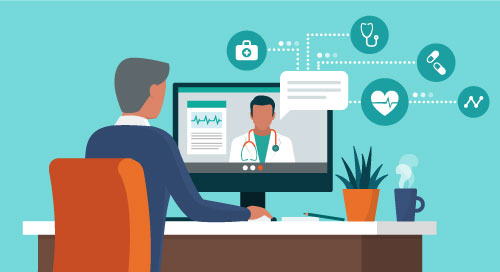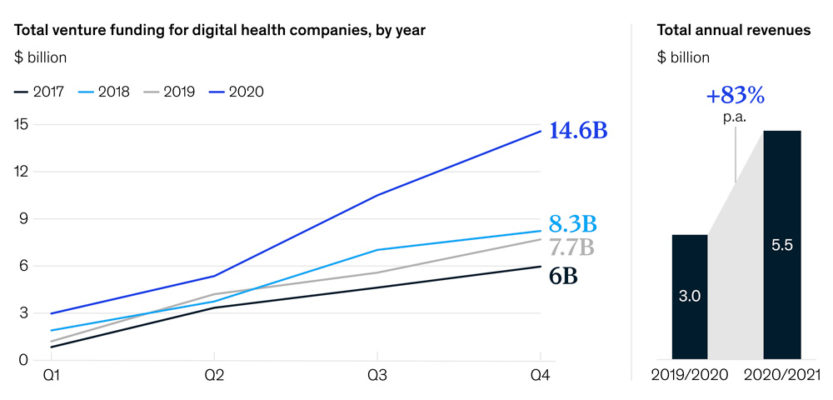New Healthcare Demands Present SIs with New Opportunities

The pandemic forced healthcare organizations to quickly come up with new digital strategies and address gaps it had been putting off. Virtual care or telehealth, health-monitoring devices, artificial intelligence, and the cloud were used to address the immediate impact from the pandemic, and as a result have forever changed the expectations of the healthcare industry.
While these technologies were implemented out of necessity, the added benefits are giving systems integrators (SIs) new possibilities to expand healthcare’s digital strategies. With healthcare organizations and hospitals seeing less of a strain on resources and more areas for revenue, and patients receiving better access to care and an overall easier experience, there are new opportunities to advance and improve upon these digital solutions in the future as more organizations look to invest in the digital health space (Figure 1).

“These solutions are definitely key to success…with a greater opportunity within the healthcare space,” says Matt Jordan, Healthcare Business Development Manager at BlueStar, a global distributor supporting SIs, VARs, and MSPs. “Telehealth is obviously not going to go away. I think it’s one of the things where it probably would have been implemented sooner, but you just may not have had the strength of some of the software partners that had their solution baked and ready to go.”
Healthcare’s Accelerated Digital Transformation
Telehealth was the only immediate solution that could deal with the demand of COVID, Jordan explains. Hospitals were at overcapacity and having to open temporary triage stations to treat everyone. On top of that, patients still had appointments, medications, and treatments they could not wait until the unforeseeable future to receive.
“Telehealth became the only stopgap measure that health systems quickly had to adopt as a technology because you simply couldn’t get in the door,” says Jordan.
So, as a reactive measure, healthcare organizations started to make use of consumer video conference solutions like Google Meet and Zoom. Once the initial shock of COVID-19 wore off, the industry started to realize these solutions were not built or ideal for healthcare services. It started to look for more proactive approaches to addressing the new demands.
With almost every aspect of healthcare now impacted – communication systems, supply chain, standard care services – the industry turned to partners and SIs to tackle healthcare’s specific needs.
With #healthcare organizations and #hospitals seeing less of a strain on resources and more areas for revenue due to virtual care, there are new opportunities to advance and improve upon #digital solutions. @think_bluestar via @insightdottech
For instance, telehealth had to be reimagined to not only provide home access to healthcare providers but limit physician interaction with infected patients through remote patient monitoring at home and in the hospital.
At the beginning of the pandemic, BlueStar ISV partner VeeMed worked with healthcare system provider Banner Health to transform existing hospital TVs and displays into telehealth endpoints leveraging its virtual care platform. This allowed Banner physicians to gain instant feedback about a patient or conduct immediate telehealth sessions without having to expose themselves to the virus.
There was also a huge demand for temperature monitoring or screening to make sure anyone granted access into a hospital or building was not running a fever and putting everyone at risk. Video and photo editing software provider CyberLink redesigned its AI facial recognition technology solution FaceMe to take temperatures, check for proper-fitting face masks, and ensure social distancing, explains Michael Freeman, Networking Practice Lead at BlueStar.
“You could do all this through walking through a gateway, so to speak, that had cameras on it and thermal sensors on it, and had AI capabilities built into it from a platform perspective, and be able to very quickly recognize whether this person was conforming with the requirements that were in place,” he says.
CyberLink was able to repurpose this technology for the healthcare industry by partnering with BlueStar, which brought together servers, cameras, and sensors from IoT supplier Advantech to FaceMe. The solution also leveraged Intel® OpenVINO™ for its AI capabilities and flexibility.
“We bring the piece parts together,” says Freeman. “We’re really trying to stay ahead of that curve, look at all the software entities out there and what they do, and how they can interplay with some of the other technologies that we offer.”
The Future of Healthcare Solutions
Freeman sees facial recognition technology like FaceMe being used at events to screen large numbers of people at once or provide people access to parts of a building without having to use a keycard.
But for these technologies to continue to transform and add value to ongoing wants and expectations, it will take collaboration and partnership with hardware and software providers. Just as VeeMed did with Banner Health, BlueStar works with partners to analyze healthcare demands and understand net new growth opportunities. Jordan explains that just remote patient monitoring alone is going to be worth $117 billion by 2025.
“It’s really just more of engagement and networking with some of the key hardware providers, with some of the key software providers like VeeMed, for example, with their telehealth platform and understanding just some of the educational pieces of the technology,” he says.
Through BlueStar’s healthcare initiative VARMED, it identifies key players in the space, takes time to vet solutions, creates unique healthcare services, and educates and trains its partner community so they can feel confident these applications will be successful.
Freeman adds that BlueStar’s partnership with Intel has also been key in introducing new opportunities and onboarding different partners to build solutions.
“Our relationship with Intel continues to grow, coming out of a pilot to a tier-two aggregator, and part of that benefit has been the bilateral introduction of different software and hardware platforms that can be utilized to put together a solution. I think that’s been an invaluable part of our relationship thus far,” says Freeman.
Jordan expects to see more tools and technology that help healthcare providers retain staff, maintain operational efficiency, minimize potential patient errors, provide more convenience to care, and better access to information in the future.